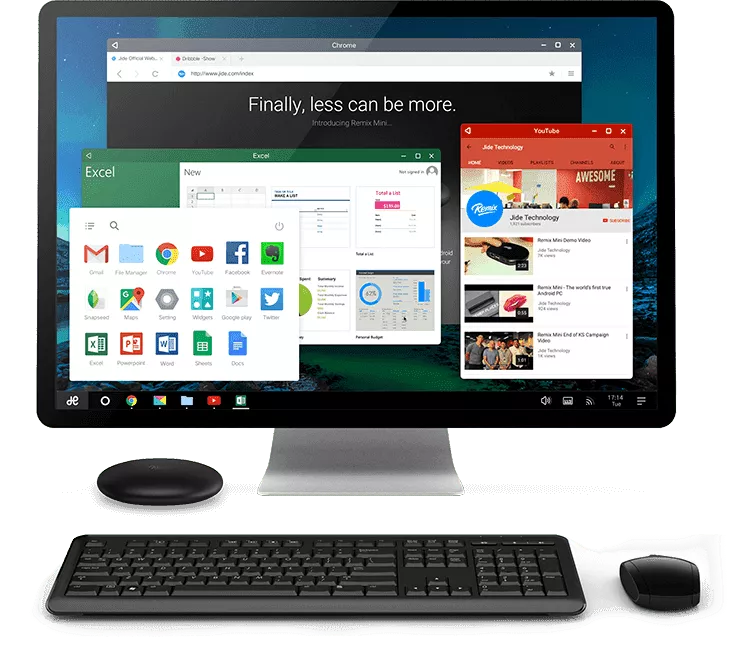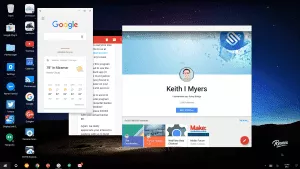Unorthodox Computer Challenge : Final Thoughts on the RemixMini

It has only been 2 short weeks since I replaced my primary computer with the Android Powered RemixMini PC and I am sort of torn on this one. One one hand, I am already deeply engrained into the Android ecosystem but; on the other hand, this experiment shows that Android may not be ready to be a desktop operating system. In this post, I will be giving my final thoughts about the RemixMini.
Disclaimer: This Page Has Been Archived
Please note that this blog post has been archived and may contain information that is outdated, defunct, or covers topics that are no longer of interest. It is being kept available solely for reference purposes, in case others might find portions of it useful.
For more recent and up-to-date tutorials, I recommend visiting KMyers.me or other websites that specialize in the topic you are interested in. It is always advisable to seek the most current information to ensure accuracy and relevance.
Overview
This challenge ran from November 29th to December 13th of 2015. For this challenge, I replaced my primary PC with the (Affiliate Link)Android-powered RemixMini desktop computer. This $70.00 computer packs the following specifications:
- 64bit Quad-Core Allwinner A53 Cortex Processor clocked at 1.2 GHZ
- 2GB RAM
- 16 GB eMMC Storage + MicroSD Card
- 802.11 b/g/n WiFi
- Bluetooth 4.0
- 10/100 Ethernet Port
- 2 USB 2.0 Ports
- 1 Full-Size HDMI Port
The whole unit is powered by a custom build of Android 5.1 known as RemixOS. Unlike the classic build of Android 5.1, RemixOS takes multitasking to a new level by introducing the ability for each application to run in its own independent,floating window – similar to how every other desktop operating system works. In principle, this is a welcome change however not all Android applications tend to play well with being in its own Window (more on that later).
Initial Setup

Setting up the RemixMini was very painless, you only need to connect a Keyboard, Mouse, HDMI monitor and the included power supply to get started. The RemixMini boots in a few seconds and you will want to check for updates in the Settings Application to ensure you are running the latest firmware before putting the RemixMini to use. Once all the RemixOS updates are completed, simply launch the Google Play Store to go through the process of adding your Google Account and downloading your choice of applications.
General Use

Just as I did with the Vensmile Mini PC Final Thoughts, I want to highlight a few basic use cases that a typical user would likely go through to see how the RemixMini works in the real world.
- Web Browsing – Web Browsing on the RemixMini worked well via the Google Chrome Web Browser. Multiple tabs work well but keep in mind that you can only have one instance of each application open at a time so there is no way to have 2 Chrome instances side by side. Page rendering times were acceptable but not mind blowing.
- Word Processing –I had no issues with word processing on the RemixMini. Google Docs, Microsoft Office, and WPS office all worked perfectly without issue.
- Accessing Streaming Media – I had no issues playing content from YouTube, Netflix or other Streaming Services aside from the lower volume. You will need to limit your multi-tasking in many cases or you may notice a drop in framerates.
- Games – Gaming on the RemixMini can be a mixed bag of nuts due to the fact that the RemixMini replaces a traditional touchscreen with a keyboard and mouse. Many Android games are designed for touch and some will not respond to mouse input at all. Simple games such as Angry Birds will work but racing games or games that use multi-touch will not work unless you pair a Bluetooth Remote Control (if the game supports Bluetooth controllers). I did try to get Starcraft running on this but was not successful.
Problems
After 2 weeks of using the RemixMini as my primary machine. I have noticed a few issues that could be problematic for some.
The RemixMini hardware was clearly designed to come in at a low price point and as such theymade several sacrifices that become obvious within the first few hours. The lack of 802.11 a/c WiFi, lack of a microphone, a USB 3.0 Port and a slow eMMC storage module are probably the worst parts of the RemixMini.
The other shortcomings of the RemixMini come down to the software, which is not the fault of RemixOS rather Android. Android and applications written for Android were clearly designed for touch and to be the only application presented to the user at any given time. Not all applications can run in windowed-mode such as many games and Google Hangouts.
The final problem I came across is that your monitor needs to use HDMI, you cannot use an HDMI to DVI converter which does rule out many monitors.
Conclusion
The RemixMini was an interesting computer to use that actually worked much better than I expected but without its faults. Jide, the company behind the RemixMini seems to be working hard to improve the units and are working on releasing several updates over the next few months. Netflix for example; refused to work when I started this challenge but was fixed 2 days into the challenge via an update to RemixOS.
I did find that I was able to adjust to RemixOS better than I expected but this does not shock me as I already make heavy use of Android and most of the applications I use on a daily basis worked just as they would on my tablet or phone.
I could honestly find myself recommending the RemixMini to parents that want to teach their kids basic computer skills without worrying about the costs of a more expensive machine. The machine does lack parental control software so supervision is a must.